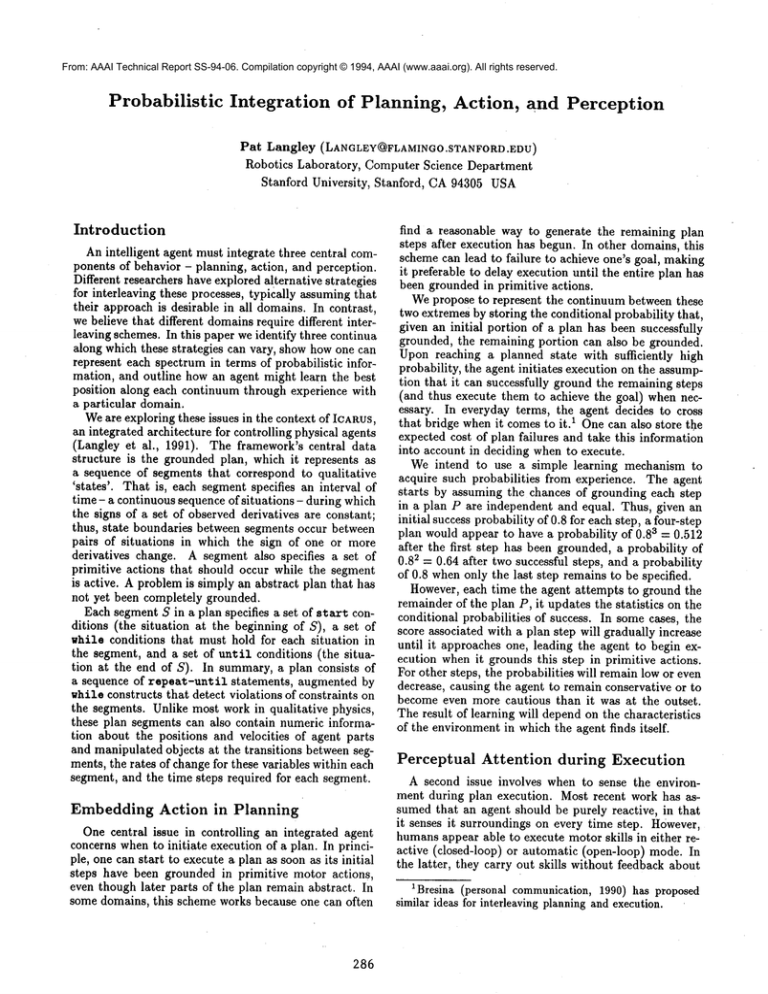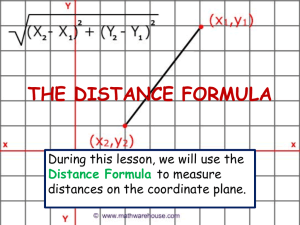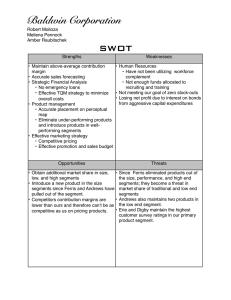
From: AAAI Technical Report SS-94-06. Compilation copyright © 1994, AAAI (www.aaai.org). All rights reserved.
Probabilistic
Integration
of Planning,
Action,
and Perception
Pat Langley (LANGLEY~FLAMINGO.STANFORD.EDU)
Robotics Laboratory, Computer Science Department
Stanford University, Stanford, CA94305 USA
Introduction
find a reasonable way to generate the remaining plan
steps after execution has begun. In other domains, this
An intelligent agent must integrate three central com- scheme can lead to failure to achieve one’s goal, making
ponents of behavior - planning, action, and perception.
it preferable to delay execution until the entire plan has
Different researchers have explored alternative strategies
been grounded in primitive actions.
for interleaving these processes, typically assumingthat
Wepropose to represent the continuum between these
their approach is desirable in all domains. In contrast,
two extremes by storing the conditional probability that,
we believe that different domainsrequire different intergiven an initial portion of a plan has been successfully
leaving schemes. In this paper we identify three continua
grounded, the remaining portion can also be grounded.
along which these strategies can vary, show how one can
Upon reaching a planned state with sufficiently
high
represent each spectrum in terms of probabilistic inforprobability, the agent initiates execution on the assumpmation, and outline how an agent might learn the best
tion that it can successfully ground the remaining steps
position along each continuum through experience with
(and thus execute them to achieve the goal) when neca particular domain.
essary. In everyday terms, the agent decides to cross
Weare exploring these issues in the context of ICARUS, that bridge when it comes to it. 1 One can also store the
an integrated architecture for controlling physical agents
expected cost of plan failures and take this information
(Langley et al., 1991). The framework’s central data
into account in deciding when to execute.
structure is the grounded plan, which it represents as
We intend to use a simple learning mechanism to
a sequence of segments that correspond to qualitative
acquire such probabilities
from experience. The agent
’states’. That is, each segment specifies an interval of
starts by assuming the chances of grounding each step
time - a continuous sequence of situations - during which
in a plan P are independent and equal. Thus, given an
the signs of a set of observed derivatives are constant;
initial success probability of 0,8 for each step, a four-step
thus, state boundaries between segments occur between
plan would appear to have a probability of 0.83 = 0.512
pairs of situations in which the sign of one or more
after the first step has been grounded, a probability of
derivatives change. A segment also specifies a set of
0.82 = 0.64 after two successful steps, and a probability
primitive actions that should occur while the segment
of 0.8 whenonly the last step remains to be specified.
is active. A problem is simply an abstract plan that has
However, each time the agent attempts to ground the
not yet been completely grounded.
remainder of the plan P, it updates the statistics on the
Each segment S in a plan specifies a set of start conconditional probabilities of success. In somecases, the
ditions (the situation at the beginning of S), a set
score associated with a plan step will gradually increase
while conditions that must hold for each situation in
until it approaches one, leading the agent to begin exthe segment, and a set of until conditions (the situaecution when it grounds this step in primitive actions.
tion at the end of S). In summary, a plan consists of
For other steps, the probabilities will remain low or even
a sequence of repeat-until
statements, augmented by
decrease, causing the agent to remain conservative or to
while constructs that detect violations of constraints on
become even more cautious than it was at the outset.
the segments. Unlike most work in qualitative physics,
The result of learning will depend on the characteristics
these plan segments can also contain numeric informaof the environment in which the agent finds itself.
tion about the positions and velocities of agent parts
and manipulated objects at the transitions between segPerceptual Attention during Execution
ments, the rates of change for these variables within each
segment, and the time steps required for each segment.
A second issue involves when to sense the environment during plan execution. Most recent work has asEmbedding Action in Planning
sumed that an agent should be purely reactive, in that
it senses it surroundings on every time step. However,
One central issue in controlling an integrated agent
humansappear able to execute motor skills in either reconcerns whento initiate execution of a plan. In princiactive (closed-loop) or automatic (open-loop) mode.
ple, one can start to execute a plan as soon as its initial
the latter, they carry out skills without feedback about
steps have been grounded in primitive motor actions,
even though later parts of the plan remain abstract. In
1Bresina (personal communication, 1990) has proposed
some domains, this scheme works because one can often
similar ideas for interleaving planning and execution.
286
the effects of their actions to ensure proper execution.
Langley, Iba, and Shrager (1994) present an analysis
reactive and automatic behavior which shows that, if one
takes the cost of sensing and the probability of errors
into account, automatic execution is clearly preferable
for some domains.
As Iba and Langley (1987) have noted, closed-loop
and open-loop behavior are merely extreme points along
a continuum. An agent can take different positions on
this continuum by varying the frequency with which it
compares situations in the environment with while and
ua~ilconditions. This is turn can be determined by
information stored on plan segments about the probability of external interruptions, the variation in timing;
and the cost of sensing. Briefly, segments that have a
high probability of completion without error, that run
for predictable lengths of time, and that have high sensing costs are likely candidates for automatic execution.
One can also reduce execution costs by selectively attending to features based on statistical information.
For a given plan, one should be able to determine the
appropriate position along this spectrum through learning. Suppose the agent has retrieved or generated a plan,
but that this structure contains no information about
the number of time steps required for execution or the
probability of successful execution. Practice occurs in
closed-loop, reactive mode, since this provides the feedback necessary to determine when errors occur and when
a segment is complete. On every practice run, the agent
updates its statistics about the time taken for each segment, the probability that the segment completed successfully without intervention, and the cost of sensing.
For some segments, external factors commonlyinterfere with successful completion, so the associated probability is low. In such cases, the agent never movesbeyond closed-loop mode, since open-loop processing does
not provide the sensory information needed to detect
and recover from errors or interference. For other segments, such interference is rare, giving a high probability of successful completion, but the variance in timing
is high. Again the agent must remain in closed-loop
mode, in this case to detect completion. However, in
some segments the probability of completion is high and
the timing variance is low. For such components of a
plan, the agent will gradually come to automatically execute the primitive actions the estimated number of time
steps, without stopping to check the while or until conditions, monitoring execution infrequently or not at all,
and thus freeing perceptual resources for other tasks.
In summary,our design for an integrated architecture
gives a central role to probabilistic information about the
probability of successfully completing plans, the probability of executing them without errors, and the relative importance of the final states. Different environments reflect different distributions, which in turn recommenddifferent strategies for interleaving of perception, action, and planning. However, simple learning
algorithms should let an agent infer this distributional
information from experience, and thus approach the optimal strategy as it becomesfamiliar with a domain. We
are implementing these ideas in the ICARUS
architecture,
and we plan to evaluate them in domains that require an
integrated agent, such as the control of a flight simulator.
Perceptual Interruptions
References
to Planning
A final issue concerns the impact of perception on the
planning process. During sensing, an agent may recognize a situation that suggests a new problem, which
it then passes on to the planning module. We posit
the existence of problem-generating triggers or reflexes
that take the same form as stored plans, but that
match against environmental states rather than stategoal pairs. In such situations, the agent can ignore the
new problem or attend to it, either abandoning its pre-
287
vious task or putting it on hold. The outcome of this
decision depends on the relative importance of the two
tasks and the expected cost of interruption and recovery.
To resolve such conflicts, we propose that the architecture associate priorities with every state in memory.On
each cycle, the agent attends to the problem with the final state having the highest priority, using an agenda to
focus its problem-solving attention. Rather than using
an explicit depth-first search regimen, planning passes
control from problem to subproblem through propagated
priority scores, causing the parent to becomesuspended
until the child has been solved or abandoned. At the
same time, the perceptual process continually adds new
problems to the agenda, based on stored plans whose
initial state matches the environmental state. If the retrieved problem has higher priority than the currently
active one, the agent suspends the latter and pursues
the more urgent goal. Once this task has been handled,
control passes back to the original problem, unless another one has taken over in the meantime.
The agent needs some means to estimate the priority
distributions associated with each stored plan. For this,
we propose that it collect statistics about the observed
desirability of the final state for each plan once it has
been achieved. Weassume that certain states have innate priorities associated with them, but that most are
initially neutral. However, states that occur along the
path to a state with an innate priority come to acquire
their ownpriority distributions through the propagation
that occurs during planning. This gives an effect similar to that in reinforcement learning; over time, the expected score for a state that occurs early along a path
will approximate the innate score for the final state.
Conclusion
Iba,W., & Langley, P. (1987). A computational theory
motor learning. Computational Intelligence, 3,338-350.
Langley, P., McKusick,K. B., Allen, J. A., Iba, W. F.,
& Thompson, K. (1991). A design for the ICARUS
architecture. SIGARTBulletin, P, 104-109.
Langley, P., Iba, W., & Shrager, J. (1994). Reactive and
automatic behavior in plan execution. Unpublished
manuscript, Robotics Laboratory, Stanford University, Stanford, CA.






